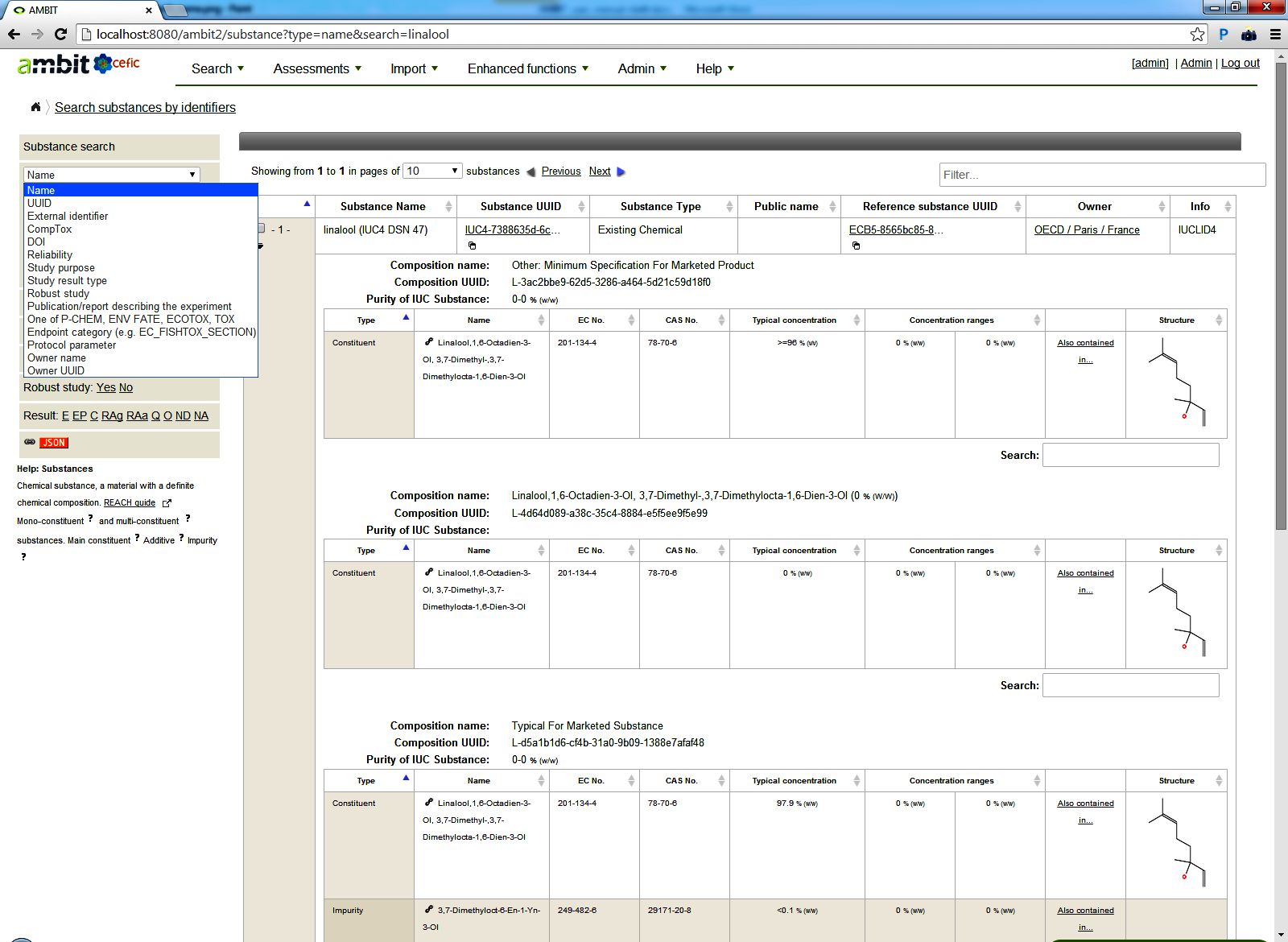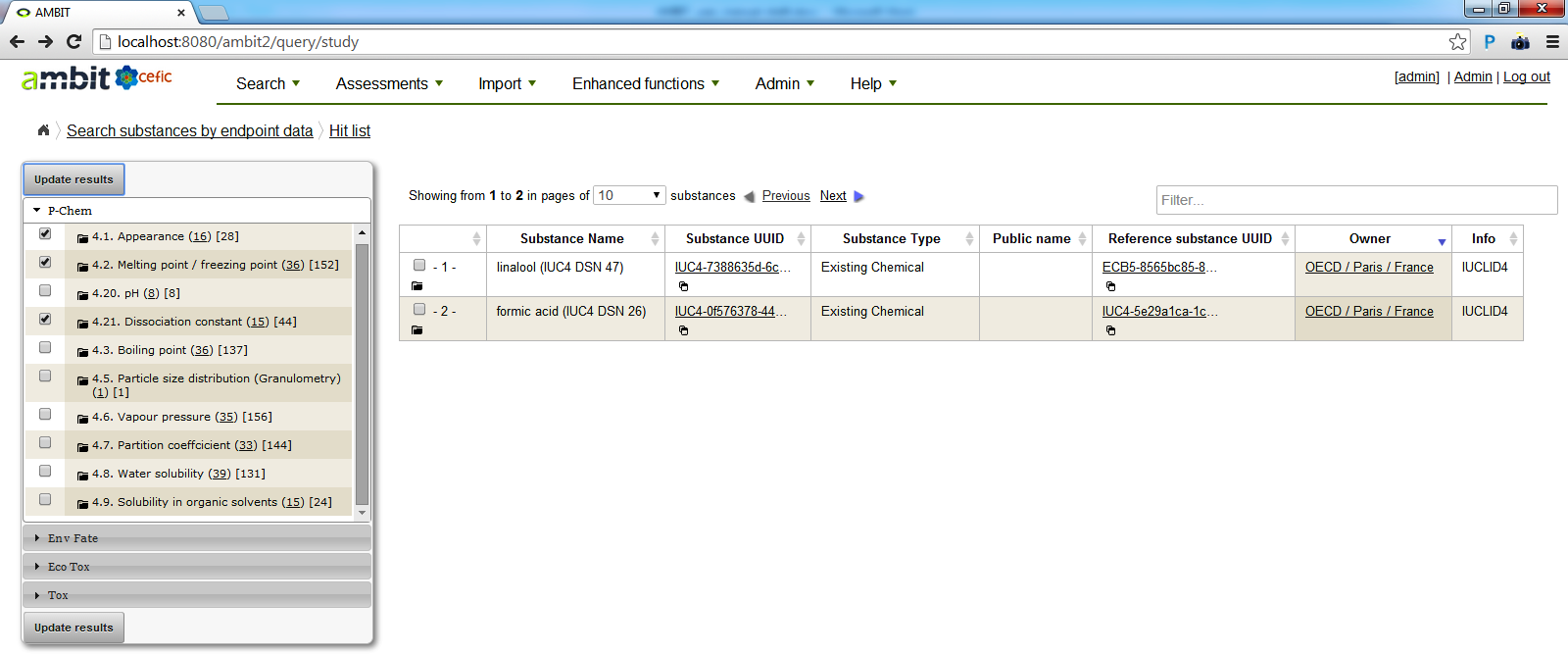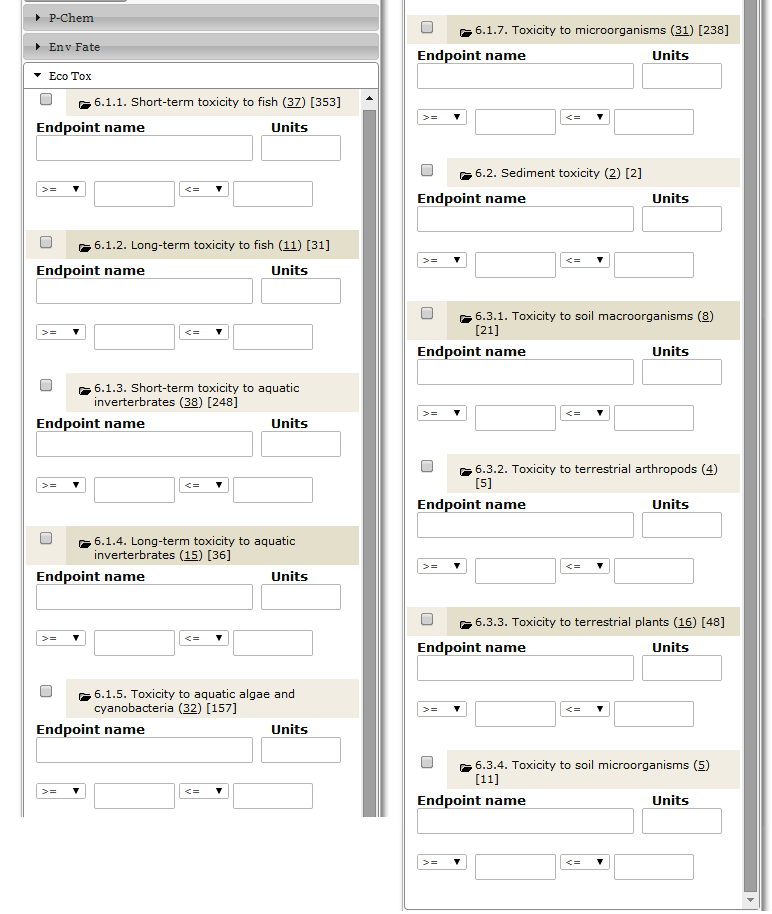Quick user guide (Nanomaterials search)
[UNDER DEVELOPMENT]
Menu: Search
Search substances by identifiers
While the Search/Search structures and associated data allows to search for chemical structures and retrieve associated substances and data; the next two menu items allow to search for chemical substances by various criteria.
The Search/Search substances by identifiers menu allows to search substances by UUID, names, external identfiiers and various criteria. The result is a list of chemical substances, composition and other details can be displayed through the folder icon.

Clicking on the Substance UUID link leads to a substance page, displaying substance identifiers, composition, physicochemical, ecotoxicological, environmental date and toxicological properties.

Clicking on the Owner link leads to a page, showing all substances by the selected owner.

Search substances by endpoint data
The Search/Search substances by endpoint data menu allows to search substances by endpoint data.
The available endpoints are listed on the left, grouped in four categories (P-Chem, Env Fate, Eco Tox, Tox). Check one or more checkboxes (can be from several categories) and click the Update results button to show the substances, having the selected type of data. The endpoints are combined by AND. The screenshot below shows there are only two substances having data for the three selected endpoints (Appearance, Melting point and Dissociation constant), although there are 16 substances with data for appearance, 36 substances with melting point values and 15 substances with dissociation constant (the first figure in the brackets is the number of substances, the figure in the square brackets is the number of values).

The folder icon at each endpoint row allows to set detailed search criteria for each endpoint. The following four screenshots show the available search criteria for phys chem properties, environmental fate endpoints, ecotox and toxicological endpoints..

P-Chem endpoints search criteria expanded

ECO TOX endpoints search criteria expanded

Env Fate endpoints search criteria expanded

TOX endpoints search criteria expanded
All text boxes support autocompletion, i.e. the available values will be displayed and can be selected by either pressing an arrow down button (to list all available values) or by entering the first letters of a possible value.

Env. Autocomplete (biodegradation parameter). The number in the brackets is the number of values available.
Note: when using endpoint selection criteria, the endpoint checkboxes should be checked; otherwise the endpoint will be ignored. Once the criteria are filled in, press Update results button. The list of substances will appear similar to the substances list described above.
Menu: Search
Search structures and associated data
Menu: Import
Chemical substance, a material with a definite chemical composition.
The REACH Guide defines Mono-constituent (a substance with one main constituent) and Multi-constituent substances (a substance with two or more main constituents).
-
The Main constituent is defined as a constituent, not being an additive or impurity, in a substance that makes up a significant part of that substance. Contributes to the naming of the substance. Concentration of the main constituent(s) is equal to the purity of the substance.
-
An Additive is a substance that has been intentionally added to stabilise the substance. Contributes to the substance composition (but not to the naming).
-
An Impurity is an unintended constituent present in a substance, as produced. Does not contribute to the naming of the substance.
Supported Endpoint study records / IUCLID5.5. XML Schema)
| 4.1. | Appearance GI_GENERAL_INFORM |
| 4.2. | Melting point / freezing point PC_MELTING |
| 4.3. | Boiling point PC_BOILING |
| 4.5. | Particle size distribution (Granulometry) PC_GRANULOMETRY |
| 4.6. | Vapour pressure PC_VAPOUR |
| 4.7. | Partition coefficient PC_PARTITION |
| 4.8. | Water solubility PC_WATER_SOL |
| 4.9. | Solubility in organic solvents PC_SOL_ORGANIC |
| 4.20. | pH PC_NON_SATURATED_PH |
| 4.21. | Dissociation constant PC_DISSOCIATION |
| 4.24. | Agglomeration/aggregation AGGLOMERATION_AGGREGATION |
| 4.25. | Crystalline phase CRYSTALLINE_PHASE |
| 4.26. | Crystallite and grain phase CRYSTALLITE_AND_GRAIN_SIZE |
| 4.27. | Aspect ratio/shape ASPECT_RATIO_SHAPE |
| 4.28. | Specific surface area SPECIFIC_SURFACE_AREA |
| 4.29. | Zeta potential ZETA_POTENTIAL |
| 4.30. | Surface chemistry SURFACE_CHEMISTRY |
| 4.31. | Dustiness DUSTINESS |
| 4.32. | Porosity POROSITY |
| 4.33. | Nanomaterial pour density POUR_DENSITY |
| 4.34. | Nanomaterial photocatalytic activity PHOTOCATALYTIC_ACTIVITY |
| 4.36. | Nanomaterial catalytic activity CATALYTIC_ACTIVITY |
| 5.1.1. | Phototransformation in Air TO_PHOTOTRANS_AIR |
| 5.1.2. | Hydrolysis TO_HYDROLYSIS |
| 5.2.1. | Biodegradation in water - screening tests TO_BIODEG_WATER_SCREEN |
| 5.2.2. | Biodegradation in water and sediment: simulation tests TO_BIODEG_WATER_SIM |
| 5.2.3. | Biodegradation in Soil EN_STABILITY_IN_SOIL |
| 5.3.1. | Bioaccumulation: aquatic / sediment EN_BIOACCUMULATION |
| 5.3.2. | Bioaccumulation: terrestrial EN_BIOACCU_TERR |
| 5.4.1. | Adsorption / Desorption EN_ADSORPTION |
| 5.4.2. | Henry's Law constant EN_HENRY_LAW |
| 6.1.1. | Short-term toxicity to fish EC_FISHTOX |
| 6.1.2. | Long-term toxicity to fish EC_CHRONFISHTOX |
| 6.1.3. | Short-term toxicity to aquatic inverterbrates EC_DAPHNIATOX |
| 6.1.4. | Long-term toxicity to aquatic inverterbrates EC_CHRONDAPHNIATOX |
| 6.1.5. | Toxicity to aquatic algae and cyanobacteria EC_ALGAETOX |
| 6.1.7. | Toxicity to microorganisms EC_BACTOX |
| 6.2. | Sediment toxicity EC_SEDIMENTDWELLINGTOX |
| 6.3.1. | Toxicity to soil macroorganisms EC_SOILDWELLINGTOX |
| 6.3.2. | Toxicity to terrestrial arthropods EC_HONEYBEESTOX |
| 6.3.3. | Toxicity to terrestrial plants EC_PLANTTOX |
| 6.3.4. | Toxicity to soil microorganisms EC_SOIL_MICRO_TOX |
| 7.2.1. | Acute toxicity - oral TO_ACUTE_ORAL |
| 7.2.2. | Acute toxicity - inhalation TO_ACUTE_INHAL |
| 7.2.3. | Acute toxicity - dermal TO_ACUTE_DERMAL |
| 7.3.1. | Skin irritation / Corrosion TO_SKIN_IRRITATION |
| 7.3.2. | Eye irritation TO_EYE_IRRITATION |
| 7.4.1. | Skin sensitisation TO_SENSITIZATION |
| 7.5.1. | Repeated dose toxicity - oral TO_REPEATED_ORAL |
| 7.5.2. | Repeated dose toxicity - inhalation TO_REPEATED_INHAL |
| 7.5.3. | Repeated dose toxicity - dermal TO_REPEATED_DERMAL |
| 7.6.1. | Genetic toxicity in vitro TO_GENETIC_IN_VITRO |
| 7.6.1. | Genetic toxicity in vivo TO_GENETIC_IN_VIVO |
| 7.7. | Carcinogenicity TO_CARCINOGENICITY |
| 7.8.1. | Toxicity to reproduction TO_REPRODUCTION |
| 7.8.2. | Developmental toxicity / teratogenicity TO_DEVELOPMENTAL |
